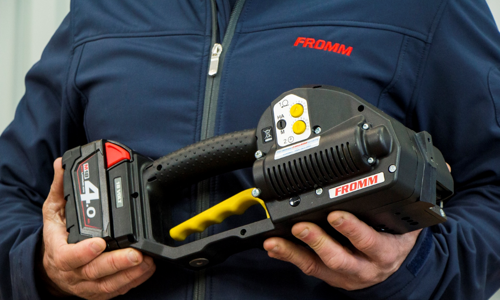Manual vs. Battery Powered Strapping Tools
Choosing the Best Strapping Tool: Manual vs Battery Powered
Selecting the right strapping tool can significantly impact packaging speed, consistency, and worker safety. As businesses grow over time many seek to improve operational efficiency, need to weigh the pros and cons of manual vs battery powered strapping tools.
Whether you're a small business strapping occasionally or a higher volume operation seeking repeatable performance, this guide will help you compare your options and make the best choice.

Why Strapping Tool Choice Matters
Strapping tools play a crucial role in load containment across industries such as logistics, warehousing, manufacturing, and construction. The right tool not only speeds up the packaging process but also reduces worker fatigue and ensures consistent tension — key for maintaining load integrity during transit and storage.
With more businesses looking for faster, more efficient options, the choice between manual and battery powered tools is more relevant than ever.
Manual Strapping Tools: Pros and Cons
Manual strapping tools use a tensioner, a sealer, and metal seals to secure either polyester (PET), polypropylene (PP), or steel strapping around packages. These tools don’t require power and are best suited for low frequency or remote strapping applications.
Pros
- Low upfront cost
- No need for electricity or batteries
- Lightweight and portable
- Simple to operate for occasional use
Cons
- Slower and more labour intensive
- Inconsistent tension & sealing (operator dependent)
- Increased risk of strain or injury over time
- Not ideal for high volumes
FROMM offers a full range of manual strapping tools for businesses that only strap occasionally or are more budget conscious.
Battery Powered Strapping Tools: Pros and Cons
Battery powered tools are designed for speed, safety, and repeatability. With adjustable tension and automatic sealing, these tools streamline the strapping process — perfect for higher volume applications using PET or PP strapping. There are powered tool options suitable for steel strapping, but these are pneumatic powered rather than battery.
Pros
- Fast operation and high throughput
- Consistent tension and sealing
- Reduced manual effort and ergonomic design
- Pre-sets for different load types
- Long life battery
Cons
- Higher upfront investment
- Requires battery charging and basic maintenance
FROMM’s battery powered strapping tools are trusted across Australian industries for their performance, safety, and durability.
Strapping Tool Comparison
|
|
Manual Strapping Tools |
Battery Powered Strapping Tools |
|
Cost |
Lower |
Higher |
|
Speed |
Slower |
Faster |
|
Consistency |
Varies by user |
Programmable |
|
Ease of Use |
Manual effort |
1 or 2 button operation |
|
Ideal For |
Low volume |
Medium to high volume |
|
Power Required |
None |
Battery powered |
Both options serve different purposes. Explore FROMM’s manual strapping and battery strapping ranges to find a solution that fits your needs.
Choosing the Best Strapping Tool for Your Business
Packaging Volume - High volume operations benefit most from battery powered tools due to their speed and consistency. For occasional use, manual tools may suffice.
Budget - Manual tools are more affordable upfront but may cost more in the long run due to slower processing and higher labour input.
Workforce Size and Skill Level - Smaller teams or less experienced staff may benefit from the ease of use and ergonomics of battery-powered tools.
Portability vs Performance - If you need a lightweight tool for infrequent, mobile use, manual is the way to go. For repeatability and long shifts, battery tools outperform their manual counterparts.
Need help choosing the right tool? Contact us or call a FROMM expert at 1800 940 356.









